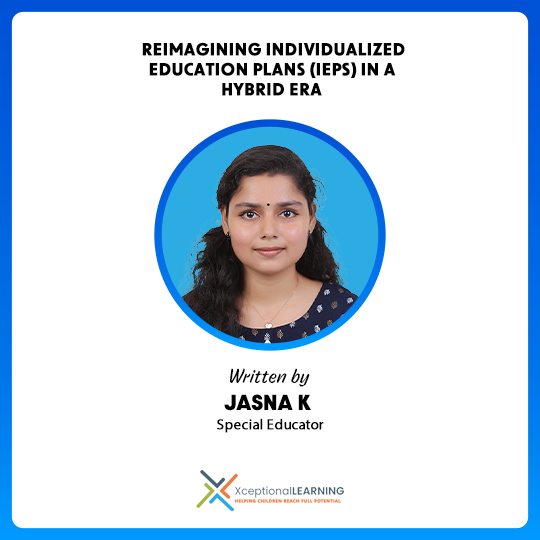Reimagining Individualized Education Plans (IEPs) in a Hybrid Era
admin November 12th, 2025

Written By
Jasna K
Special Educator
In today’s evolving educational landscape, hybrid learning—blending digital instruction with conventional teaching—has become more than an alternative. It’s transforming how learning is designed, delivered, and supported.
For special educators, this shift presents both a challenge and an opportunity: to rethink the Individualized Education Plan (IEP) so it reflects the realities of both digital and in-person environments.
IEPs have always been the cornerstone of special education—personalized roadmaps created to meet each learner’s unique needs. But in a hybrid era, where learning extends beyond classrooms and therapy rooms into digital spaces, traditional IEPs can feel static and disconnected. It’s time to reimagine them as dynamic, data-informed, and collaborative frameworks that evolve with the learner.
From Static Plans to Living Frameworks
Traditionally, IEPs were written, reviewed, and implemented within fixed intervals—often revisited only during scheduled meetings or formal reviews.
In hybrid settings, however, learning unfolds across multiple environments: classrooms, therapy sessions, and even home-based digital platforms.
This diversity demands a living IEP—one that updates in real time as the learner progresses. Rather than relying solely on observation and paperwork, digital tools now enable educators and therapists to record, monitor, and analyse performance continuously.
This shift transforms IEPs from static documents into responsive systems that adapt to each learner’s pace and progress.
The Case for Digital IEPs
Hybrid learning calls for integration, not replacement. Digital tools don’t remove the personal touch—they extend it. When used thoughtfully, they make individualized support more accessible, transparent, and consistent across all learning settings.
Here’s why reimagining IEPs through digital collaboration matters:
- Real-Time Progress Tracking: Data on learner performance—whether in academics, communication, or motor skills—can be instantly collected and visualized for educators, therapists, and parents.
- Collaborative Accessibility: Everyone involved in the learner’s development can review updates and contribute insights, ensuring continuity beyond scheduled meetings.
- Adaptive Learning: Activities and interventions adjust automatically based on progress trends, keeping instruction responsive.
- Consistent Reinforcement: Whether the learner is at school, at home, or in therapy, digital platforms ensure continuity and reinforcement of skills.
This integration bridges rehabilitation, education, and home learning, creating a seamless ecosystem centered around the learner.
Core Components of a Hybrid IEP
A well-designed hybrid IEP combines human insight with digital precision. Its key components include:
- Data-Driven Goal Setting: Measurable, clear goals informed by digital assessments and analytics.
- Continuous Feedback Loops: Timely, actionable feedback that supports growth—not just evaluation.
- Collaborative Dashboards: Shared spaces where teachers, therapists, and parents can track and update progress together.
- Adaptive Support: Learning activities evolve in response to real-time data, ensuring readiness for new challenges.
- Reflective Learning: Built-in opportunities for reflection promote self-awareness and metacognition across developmental stages.
This model doesn’t just document learning—it drives it.
Empowering Every Learner through Inclusion
Hybrid IEPs empower learners with diverse abilities by tailoring support to their individual needs and rhythms. They foster inclusion by:
- Supporting learners with multiple needs through adaptive tools and therapy-linked digital activities.
- Giving parents an active role in progress monitoring, making home practice more meaningful.
- Allowing therapists and teachers to collaborate across locations, ensuring unified goals and strategies.
- Reducing learner anxiety through ongoing, constructive feedback instead of isolated evaluations.
In essence, hybrid IEPs turn inclusion from a policy into an everyday practice.
How XceptionalLEARNING Leads This Transformation
At XceptionalLEARNING, it is believed meaningful progress occurs when technology and therapy work hand in hand.
The digital platform bridges education and rehabilitation by offering:
- Therapy-Linked Digital Activities: Designed by experts to align directly with IEP goals and developmental milestones.
- Real-Time Data Dashboards: Tools to track performance across academic, cognitive, and communication domains.
- Collaborative Access: Teachers, therapists, and parents can monitor growth and adapt interventions collaboratively.
- Digital Activity Book: Interactive tools that make therapy engaging while collecting valuable progress insights.
- Global Access to Therapy: Learners can connect with specialized therapists from anywhere in the world, ensuring continuity of care beyond geographical boundaries.
For example, a learner working on fine motor coordination might begin with digital tracing exercises that gradually increase in complexity. As they progress, the system records their accuracy, identifies readiness for the next level, and notifies the therapist—all in one integrated space.
By combining education, therapy, and family participation, XceptionalLEARNING is helping redefine how individualized plans evolve in the hybrid world.
Challenges and Considerations
Like any innovation, implementing hybrid IEPs requires thoughtful planning. Key considerations include:
- Data Privacy and Security: Protecting sensitive learner information remains a top priority.
- Training and Capacity Building: Educators, therapists, and families need support to use digital tools effectively.
- Balancing Digital and Hands-On Learning: Technology should complement—not replace—direct instruction and real-world experiences.
- Consistency and Alignment: Goals, assessments, and interventions should remain coherent across every learning setting.
When addressed with care, these challenges become opportunities to enhance inclusivity, efficiency, and connection without compromising empathy.
The Future of IEPs: Dynamic, Collaborative, and Reflective
The future of special education lies not just in adopting technology but in using it purposefully.
Hybrid IEPs mark a fundamental shift—from static paperwork to dynamic, collaborative frameworks that respond to every learner’s evolving journey.
By combining real-time data, adaptive learning, and human insight, these plans empower educators, therapists, and families to make informed decisions, provide timely support, and celebrate meaningful progress.
The goal ahead is clear: to build a future where every educational plan is as exceptional as the learner it serves.
At XceptionalLEARNING, we make every plan as unique as the learner. Through our Hybrid Therapy Services, you can connect with licensed therapists online, access specialized therapy services, and expand your therapy practice online. Contact us to experience smarter, connected, and personalized learning.

